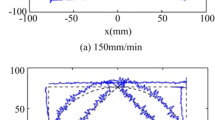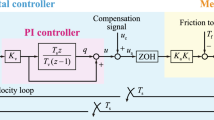Abstract
In this paper, a method of reducing the tracking error in CNC machining is proposed. The structured neural network is used to approximate the discontinuous friction in CNC machining, which has jump points and uncertainties. With the estimated nonlinear friction function, the reshaped trajectory can be computed from the desired one by solving a second order ODE such that when the reshaped trajectory is fed into the CNC controller, the output is the desired trajectory and the tracking error is eliminated in certain sense. The proposed reshape method is also shown to be robust with respect to certain parameters of the dynamic system.
Similar content being viewed by others
References
Castelino K, D’Souza R, and Wright P K, Tool path optimization for minimizing airtime during machining, Journal of Manufacturing Systems, 2003, 22(3): 173–180.
Jamhour E and André P J, Planning smooth trajectories along parametric paths, Mathematics and Computers in Simulation, 1996, 41(5–6): 615–626.
Dong J and Stori J A, A generalized time-optimal bi-directional scan algorithm for constrained feedrate optimization, ASME Journal of Dynamic Systems, Measurement, and Control, 2006, 128: 379–390.
Smith T S, Farouki R T, Timar S D, and Boyadjieff G L, Algorithms for time-optimal control of CNC machines along curved tool paths, Robotics and Computer Integrated Manufacturing, 2005, 21: 37–53.
Fan W, Gao X S, Yan W, and Yuan C M, Interpolation of parametric CNC machining path under confined jounce, The International Journal of Advanced Manufacturing Technology, 2012, 62(5–8): 719–739.
Renton D and Elbestawi M A, High speed servo control of multi-axis machine tools, International Journal of Machine Tools and Manufacture, 2000, 40: 539–559.
Dong J Y and Stori J A, Optimal feed-rate scheduling for high-speed contouring, Journal of Manufacturing Science and Engineering, 2007, 129(1): 63–76.
Lo C C, A tool-path control scheme for five-axis machine tools, International Journal of Machine Tools and Manufacture, 2002, 42(1): 37–53.
Dong S Y, Can W, Wen S, and Gang F, A synchronization approach to trajectory tracking of multiple mobile robots while maintaining time-varying formations, IEEE Transactions on Robotics, 2009, 5(5): 1074–1086.
Ernesto C A and Farouki R T, Solution of inverse dynamics problems for contour error minimization in CNC machines, The International Journal of Advanced Manufacturing Technology, 2010, 49(5–8): 589–604.
Shiller Z and Chang H, Trajectory preshaping for high-speed articulated systems, Journal of Dynamic Systems, Measurement, and Control, 1995, 117: 304–310.
Cheng F, Fan K C, Miao J W, Li B K, and Wang H Y, A BPNN-PID based long-stroke nanopositioning control scheme driven by ultrasonic motor, Precision Engineering, 2012, 36(3): 485–493.
Rastko R S and Frank L L, Neural-network approximation of piecewise continuous functions: Application to friction compensation, IEEE Transactions on Neural Networks, 2002, 13(3): 745–751.
Yau H T, Lin M T, and Tsai M S, Real-time NURBS interpolation using FPGA for high speed motion control, Computer-Aided Design, 2006, 38: 1123–1133.
Huang S N and Lee T H, Robust adaptive numerical compensation for friction and force ripple in permanent-magnet, IEEE Transactions on Magnetic, 2002, 38(1): 221–228.
Lischinsky P, Canudas-de-Wit C, and Morel G, Friction compensation for an industrial hydraulic robot, Control Systems, IEEE, 1999, 19(1): 25–32.
Zhang K, Yuan C M, and Gao X S, Efficient algorithm for time-optimal feedrate planning and smoothing with confined chord error and acceleration, The International Journal of Advanced Manufacturing Technology, 2013, 66(9–12): 1685–1697.
Author information
Authors and Affiliations
Corresponding author
Additional information
This paper is partially supported by a National Key Basic Research Project of China, by a USA NSF grant CCR-0201253, and by the Foundation of UPC for the Author of National Excellent Doctoral Dissertation under Grant No. 120501A.
This paper was recommended for publication by Guest Editor LI Hongbo.
Rights and permissions
About this article
Cite this article
Guo, J., Zhang, Q. & Gao, XS. Tracking error reduction in CNC machining by reshaping the kinematic trajectory. J Syst Sci Complex 26, 817–835 (2013). https://doi.org/10.1007/s11424-013-3179-x
Received:
Revised:
Published:
Issue Date:
DOI: https://doi.org/10.1007/s11424-013-3179-x




